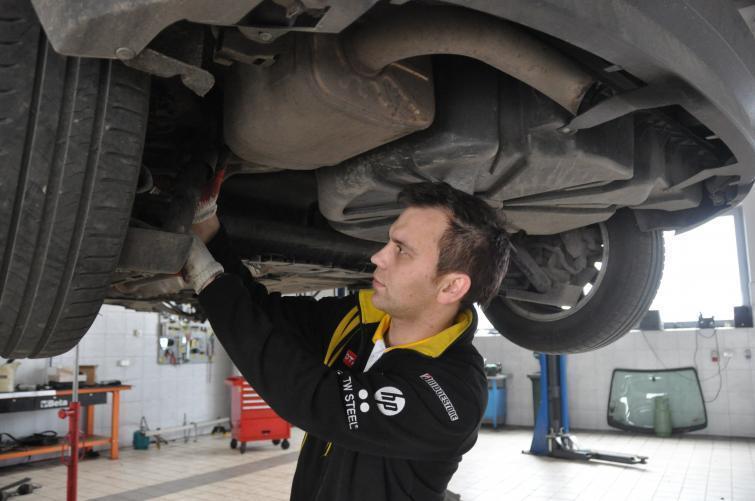
Time to Revisit Suspension - Things to Remember - Guide
 After wintering in the car, you should especially pay attention to the suspension elements, steering and the condition of the cardan joints. Shock absorbers must also be effective - they keep the wheel in constant contact with the ground and provide driving comfort.
After wintering in the car, you should especially pay attention to the suspension elements, steering and the condition of the cardan joints. Shock absorbers must also be effective - they keep the wheel in constant contact with the ground and provide driving comfort.

The continuous operation of shock absorbers while driving causes their natural and permanent wear, which depends on: mileage, vehicle load, driving style, road profile.
After driving 20 XNUMX kilometers, you should always check the condition of the shock absorbers. “They have to work at this distance about a million times. Every used car buyer should also check the condition of these items, advises Dariusz Nalewaiko, Service Manager for Renault Motozbyt in Bialystok.
ADVERTISING
Worn shock absorbers increase the risk of an accident
The mechanic emphasizes that worn shock absorbers lengthen the stopping distance. At a speed of 50 km/h. already one is used by 50 percent. shock absorber extends it by more than two meters. Riding in corners with worn shock absorbers means we start to lose control of the car at about 60 km/h, and at just over eighty we can slip into a skid.
What's more, faulty shock absorbers reduce tire life by up to a quarter. The risk of damage to the parts interacting with them also increases: cardan joints, suspension joints, engine brackets, etc.
Signs of shock absorber wear are:
– uncertain driving of the car in corners;
- the occurrence of significant inclinations (the so-called floating of the car) in turns and on bumps;
– tilting the car forward (the so-called dive) when braking;
- The dull thud of speed bumps and other side bumps when driving;
– bouncing wheels during acceleration, leading to a loss of traction;
- oil leaks from shock absorbers;
– premature, uneven tire wear.
Renault Motozbyt service specialist recalls that shock absorbers are replaced on average after 60-80 thousand mileage. km. This should be entrusted to specialists, as they are developed for each car model separately. Even the same models, but with different engines, may have different types of shock absorbers. The same applies to station wagons and, for example, sedans.
“You must remember that shock absorbers are changed in pairs for each axle,” Nalevaiko explains.
Careful suspension control
In addition to shock absorbers, it is also worth paying attention to the condition of the rocker arms, stabilizers and steering system. Warning symptoms include excessive steering wheel play, knocking while driving, and abnormal tire wear.
Don't underestimate the signs of wear on the suspension and steering. This is very dangerous, because wear is not uniform, but increases more and more. In extreme cases, this leads to a sudden detachment of the ball joint or the failure of the screw securing the rubber-metal element.
After the repair is done, it is necessary to adjust the suspension geometry. Incorrect wheel alignment is not only accelerated tire wear, but, above all, a general deterioration in vehicle stability.
Metallic knocks during start-up or vibration of the entire vehicle indicate damage to the drive joints. The hinges - especially on the front-wheel drive - work in difficult conditions, as they have to transmit loads at large angles. These elements do not like two things - a large load when turning the wheels and dirt that enters through the damaged coating. If the shell is damaged, the connection can be destroyed within a few days. It also breaks down quickly if the driver often starts off with squealing tires and additionally on twisted wheels.
End of driving
The outer hinges wear out the fastest, i.e. those on wheels, but internal hinges can also be damaged.
“As the damage progresses, the noise increases, becomes more distinct and audible with less and less twisting and less stress,” adds Dariusz Nalevaiko. – In extreme cases, the articulation may fall apart, preventing further driving.
In most cases, the wear of the internal joints is manifested in strong vibrations transmitted to the entire vehicle.
Vibrations increase during acceleration and almost completely disappear under engine braking or idling. Sometimes the vibration is caused by not enough grease in the joint, so repairs can be started by refilling it even if no leaks are visible. When this does not help, there is nothing left but to replace the hinge with a new one.
After a winter inspection, in addition to the suspension, it should include the brake system, exhaust system and bodywork, since these are the elements that are especially susceptible to corrosion after hard use in extreme weather conditions. We must also remember to review and clean the air conditioner.
Petr Valchak

